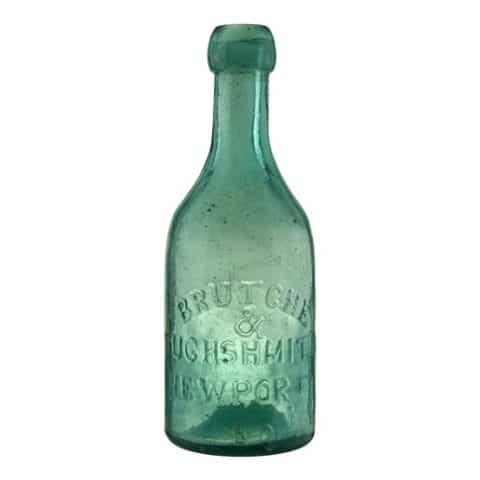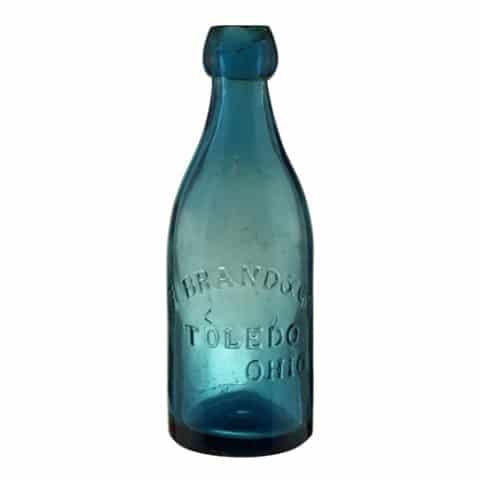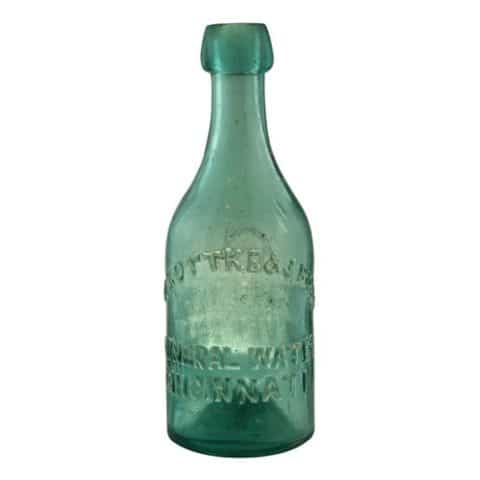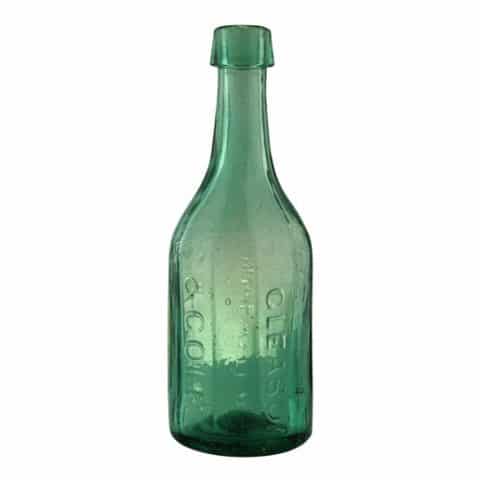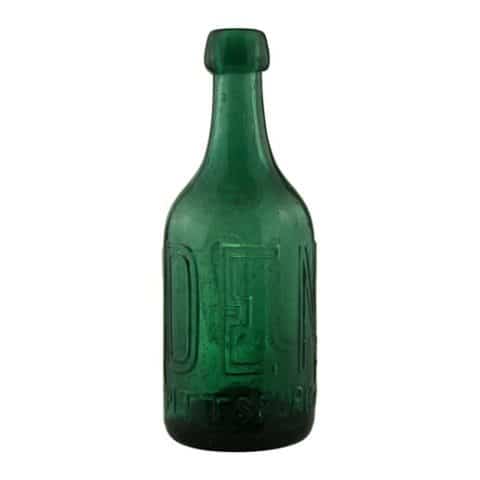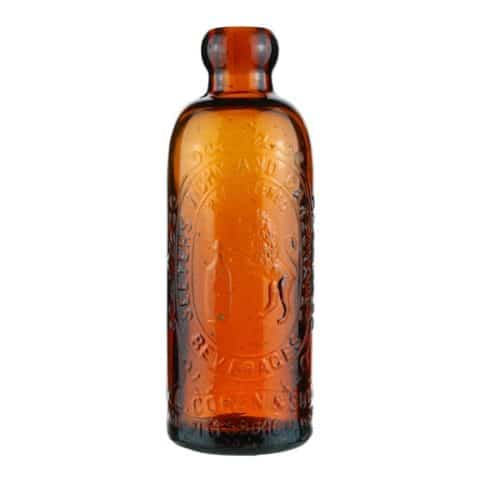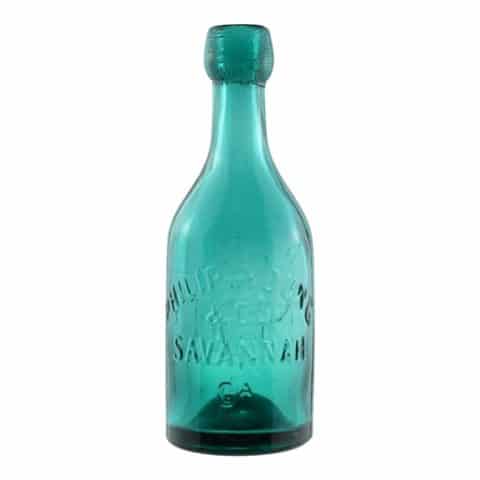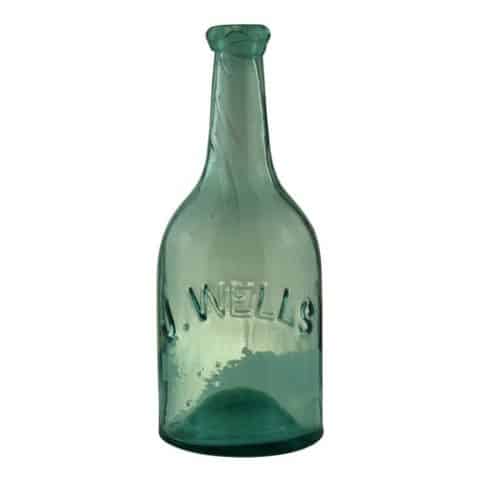Rutheford’s Premium MNineral Water – Cincinnati
Rutheford’s Premium Mineral Water
Cincinnati
This Bottle is Never Sold
Thomas M. Rutherford, Cincinnati, Ohio
Deep Aqua Soda Water
Provenance: Doug Shutler Collection

Our decadon or 10-sided deep aqua bottle is embossed, ‘RUTHERFORDS’ (side 1), ‘PREMIUM’ (side 3), ‘MINERAL WATER’ (side 5), ‘CINCINNATI’ (side 7), and ‘THIS BOTTLE IS NEVER SOLD’ (side 9). All of the other panels are blank. There is an applied tapered mouth and a deep iron pontil cavity. The bottle is considered very rare.

Many soda water bottles have an extensive base, and side wear as soda water bottles were the property of the soda bottler and were sometimes embossed like our example, ‘THIS BOTTLE IS NEVER SOLD’ or similar marking to that effect..
We have a second example of a 7 3/8″ tall, straight-line blue-green iron pontiled T. M. Rutherford’s Mineral Water Cincinnati – R – This Bottle is Never Sold in our museum. This must have been Rutherford’s standard brand as our other example uses the word “Premium.”

Thomas M. Rutherford
Thomas M. Rutherford was born in 1806 in Pennsylvania and worked in Cincinnati, Ohio as a brush manufacturer on the west side of Walnut Street between 4th and 5th Streets from 1834 to 1839.
The first half of the 1840s saw Rutherford’s name associated with fine catering events in The Cincinnati Enquirer, such as this one on August 5, 1841:
“Rutherford’s Turtle Soup – Will be served up at the Wm. Tell, Fifth Street, from half-past 10 o’clock, A.M., until half-past 2′ o’clock, P. M. every Sunday during the season. Also – Families served to order. Smith & Weatherbee.”
Tremendous Excitement. – We were attracted yesterday forenoon by a large crowd of well-dressed but lean and lank citizens, congregated in and about the Wm. Tell Exchange, and a look in soon discovered to us the cause of the commotion. Scores of plump pigeons swimming in wine, in which Rutherford had done them up to suit the most fastidious taste
The Cincinnati Enquirer, August 5th, 1841
Another one from July 20, 1843, in The Cincinnati Enquirer:
“Tremendous Excitement. – We were attracted yesterday forenoon by a large crowd of well-dressed but lean and lank citizens, congregated in and about the Wm. Tell Exchange, and a look in soon discovered to us the cause of the commotion. Scores of plump pigeons swimming in wine, in which Rutherford had done them up to suit the most fastidious taste – all the et cetera that usually accompany them in their flight to the lower regions – with juleps, lemonades, &c. &c. were there dealt out in most prodigal profusion. About quitting time, a better set of good-natured chaps could not be met with short of the Wallawalls hunting grounds.” At that time Thomas M. Rutherford was living at Brighton House, one mile northwest of Cincinnati.
An yet another in The Cincinnati Enquirer on September 22, 1843:
“To Epicures. – A lot of Fresh Oysters just received from Baltimore, in their own liquor, at the Wm. Tell Exchange. Rutherford serves up at the shortest notice Woodcock, Quail, Duck, &c., &c., in the best style.”

By 1845, Thomas Rutherford had changed directions and founded a mineral water manufacturing business built on his catering clientele. He was among one of the first mineral water manufacturers in Cincinnati. The city directory listings from 1845 to 1850 list T. M. Rutherford, manufacturer of mineral water, Church alley between 4th and 5th. An advertisement in the July 31, 1845 edition of The Cincinnati Enquirer stated that he introduced “Artificial Mineral Waters” as a wholesome and pleasant drink in the Queen City of Cincinnati. He said it was the first attempt ever made in the city. Rutherford was manufacturing and putting mineral water in glass bottles, with every variety of syrup, of his own making. He said it was “calculated for use in hotels, coffee houses, steamboats, &c.”

The difference between “soda water” and “mineral water” during the 19th century was often vague. Soda water was generally considered flavored artificial mineral water with the purposeful addition of carbonation and various compounds and flavoring. Mineral or spring water, as it was also called, would generally be natural waters from spring sources that were typically highly mineralized with carbonates like alkaline, sulfurous compounds, and or various salts, which often carbonated naturally. The confusion sometimes arises when mineral water is used as a generic term applied to various natural and artificially carbonated, non-artificially flavored waters, including many utilized for their perceived medicinal qualities. Please visit the museum Spring & Mineral Water Gallery.
By 1850, Thomas M. Rutheford’s mineral water business was passed on to his son John. The new company was called Rutherford & Co. Mineral and Soda Water Factory. It was located on Fifth Street, between Broadway and Pike. George Walton was his partner. Advertising stated “Soda Fountains sent for and Delivered Gratis.”
Thomas M. Rutherford would move back into the brush business and was listed as a bristle merchant at the same address as his son in 1850. He would die in 1855.
Primary Images: Rutherford’s Premium Mineral Water and T. M. Rutherford’s Mineral Water Cincinnati bottles imaged by the FOHBC Virtual Museum midwest studio by Alan DeMaison.
Primary Image: Museum examples of a blue-green iron pontiled T. M. Rutherford’s Mineral Water Cincinnati – R – This Bottle is Never Sold – Doug Shutler collection.
Support: Reference to Soda & Beer Bottles of North America, Tod von Mechow
Support: Reference to The American Pontiled Soda Database Project
Support Image: Cincinnati, Ohio, 1845 illustration. The map is from 1837 showing the riverfront area of Cincinnati.
Join the FOHBC: The Virtual Museum is a project of the Federation of Historical Bottle Collectors (FOHBC). To become a member.














